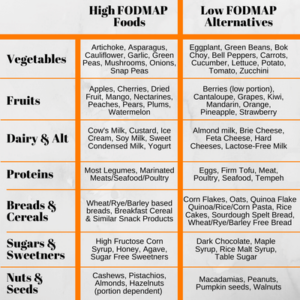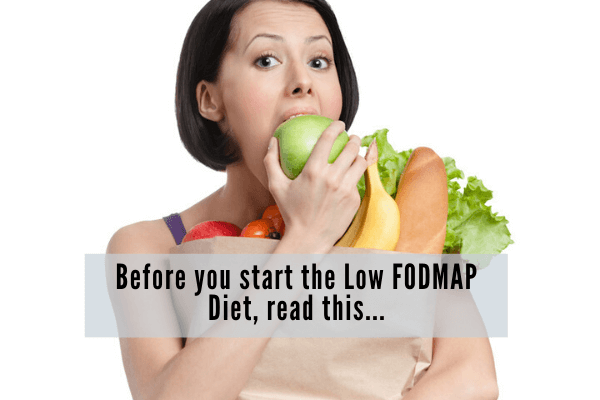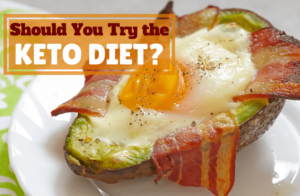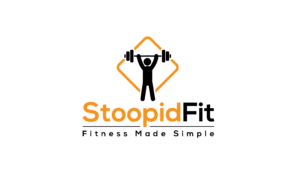There are some foods that you know to avoid – not because they’re “unhealthy” but because you know that eating them will get you later.
Those foods that don’t sit right – they get you gassy, bloated, in pain, and give you a not so fun bathroom experience.
Of course, you can choose to never have these foods again, but you love those foods and saying goodbye to them is going to be harder than your last breakup.
The good news is that you don’t have to say goodbye – but maybe taking a break from them would be a good idea.
Even though you might like the taste of these foods, your gut is in a battle with them whenever they meet – why is that?
What’s your gut’s problem with these foods?
And How can you make it better?
What are FODMAPs?
FODMAP is actually an acronym for:
Fermentable – a process in which gut bacteria ferment undigested carbs to produce gases.
Oligosaccharide – fructans and GOS (prebiotics).
Disaccharide – Lactose which can be found in dairy products.
Monosaccharide – Fructose which can be found in fruits and fruit products.
And
Polyols – Sorbitol and Mannitol which can be found in fruits, vegetables, and artificial sweeteners.
Basically, FODMAPs are individual compounds that can be found in a wide variety of foods. These compounds are basically different forms of carbohydrates that do not get completely digested or absorbed in your intestines.
Different foods have varying amounts of FODMAPs in them and consuming these foods will have different effects on different people.
What Happens When You Eat FODMAPs?
When FODMAP foods are eaten they begin to attract water as they move through the small intestine. Once they make their way past the small intestine and into the large intestine, your gut bacteria (the good bacteria that we all have) feed off of these FODMAP foods which leads to rapid fermentation and gas production.
This process is the same for all people, but individuals with more sensitive gut walls will experience extra expansion/stretching of the intestinal wall from the excess water and gas which can lead to symptoms of:
- Abdominal Pain
- Bloating
- Gas
- Constipation
- Diarrhea
Most people are able to consume high FODMAP foods daily without an issue. Individuals with gut sensitivities such as Irritable Bowel Syndrome (IBS) will experience these symptoms most often. IBS is the most common gut issue in the United States with 1 in every 7 people being diagnosed.
However, you can still experience these symptoms without an official IBS diagnosis. Individuals with IBS will have more issues with motility which is the speed of contents moving through the intestinal tract.
What Foods Are High and Low FODMAP Foods?
Here’s a pretty comprehensive list of foods that are high FODMAP and low FODMAP alternatives that you can replace:

Important notes to keep in mind:
- A lot of these foods are generally considered “healthy” this doesn’t mean that you should eliminate them from your diet forever but managing the intake of these foods could help ease some of the gastrointestinal stress you might be experiencing.
- Portion sizes play a role in the symptoms you might experience. For instance, you might not experience symptoms from a single portion of nuts but having multiple servings at once can cause irritation.
- High FODMAP foods can also be found in less obvious places like sauces, dresses, and juices that include one or more of these ingredients.
How Does A Low FODMAP Diet Work?
There are 3 parts to following a low FODMAP diet: Restrict and Replace Phase -> Reintroduction Phase -> Realization Phase
Restrict & Replace Phase:
This initial phase is where you avoid all of the high FODMAP foods listed above for a period of time and use low FODMAP alternatives. It’s important to note that you should avoid all high FODMAP foods during this time period.
Like I said at the beginning of this article – you aren’t saying goodbye to these foods, you’re just taking a break from them.The truth is we need FODMAP foods for our gut health but we also need to give out gut from the constant distress these foods give it.
Most people will experience a reduction of symptoms in this phase – which is the main goal. You want to give your gut – and yourself – relief of your symptoms for a period of time which is typically between 3-8 weeks. I always recommend erring on the side of caution and following this phase longer rather than cutting it short.
Reintroduction Phase:
Once you have restricted and replaced your FODMAP foods a period of time and have experienced relief for an adequate length of time it’s time to reintroduce those foods!
Before you go rushing to the grocery store to buy all the foods that you’ve been restricting, understand that we want to go through this reintroduction phase intelligently.
We don’t want to bring all the foods back at once because that’ll take us back to where we started. Instead, we’re going to reintroduce one food at a time.
So you’re still following the same low FODMAP diet as you were in the Restrict and Replace Phase, but you’re testing 1 specific food item for a 3 day period to see how your body reacts to each individual food.
Even if you find yourself able to tolerate a certain FODMAP food well after a 3 day period, you still need to restrict it while you test other foods individually.
The reason being is we want to identify which types of FODMAP foods you can tolerate (it’s rare to have someone sensitive to all high FODMAP foods) and the amount of FODMAP foods that you can tolerate as well!
I would suggest keeping detailed notes about how you feel, symptoms you experience, and your bowel regularity/stool type in this time period.
Realization Phase:
This is more often referred to as the “Personalization Phase” but I like alliteration and having all the phases start with “R” just sounds better to me.
In this phase, you’re taking what you learned about your body in Phase 2 in terms of what foods you can tolerate and how much of those foods you can tolerate and creating an individualized plan for yourself.
As mentioned before, every person will tolerate different foods and different amounts of those foods differently so it’s important to understand which foods and portions those are for you so that you increase the variety and flexibility of your diet.
Each phase of the low FODMAP diets is incredibly important for your long term health and symptom relief so that you can live your life with as little restriction as possible.
While in the process of your low FODMAP diet I would suggest that you:
- Work with a medical professional, RD, or nutrition coach to help guide you through the process and troubleshoot any issues that you may experience
- Track, track, track! Keep detailed notes of your bio-feedback, bowel movements, nutrient intake, symptoms, etc. so that you can accurately detect the culprits
- Be patient. This isn’t an overnight process but after spending ~12 weeks going through this process you will have a better understanding of your body that you can take with you the rest of your life!
Conclusion
The goal with the low FODMAP diet is to help alleviate your symptoms while helping you better understand what your body can tolerate without issue so that you can live a life with greater dietary flexibility.
It starts with restricting all high FODMAP foods for a period of time and replacing them with low FODMAP alternatives to alleviate symptoms. From there you reintroduce each food individually and monitor how it effects you so that you can fully realize what food work for you and which foods don’t.
Working with a nutrition coach or dietitian can be helpful when making dietary changes for your health or physique – if you feel like you could benefit from this, click here to apply for a free strategy call with one of our nutrition coaches!
**This blog does not serve as medical or dietary advice and you should consult your primary care physician for proper diagnosis and before making major changes in your diet**







